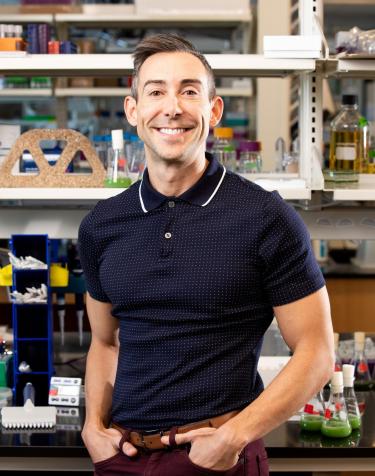
Principal Investigators
Chelsea Heveran; Wil Srubar

Funding
Defense Advanced Research Projects Agency (DARPA)

Collaboration + support
Jeffrey Cameron; Sherri Cook; Mija Hubler; Renewable and Sustainable Energy Institute (RASEI); Department of Biochemistry; National Renewable Energy Laboratory

Integrating living, multiplying bacteria could increase efficiency and sustainability of building material production and use
CU Boulder researchers have developed a new approach to designing more sustainable buildings with help from some of the tiniest contractors out there.
In a study published in the journal Matter, Wil Srubar and his colleagues describe their strategy for using bacteria to develop building materials that live and multiply—and might deliver a lower carbon footprint to boot.
“We already use biological materials in our buildings, like wood, but those materials are no longer alive,” said Srubar, an assistant professor in the Department of Civil, Environmental and Architectural Engineering (CEAE). “We’re asking: Why can’t we keep them alive and have that biology do something beneficial, too?”
Such structures could, one day, heal their own cracks, suck up dangerous toxins from the air or even glow on command.
“Though this technology is at its beginning, looking forward, living building materials could be used to improve the efficiency and sustainability of building material production, and could allow materials to sense and interact with their environment," said study lead author Chelsea Heveran, a former postdoctoral research assistant at CU Boulder, now at Montana State University.

Today's more corpse-like building materials, in contrast, can be costly and polluting to produce, Srubar said. In fact, making the cement and concrete needed for roads, bridges, skyscrapers and other structures generates nearly 6% of the world’s annual emissions of carbon dioxide.
Srubar’s solution: Hire some bacteria.
In particular, he and his colleagues experimented with cyanobacteria belonging to the genus Synechococcus. Under the right conditions, these green microbes absorb carbon dioxide gas to help them grow and make calcium carbonate—the main ingredient in limestone.
To begin the manufacturing process, the researchers inoculate colonies of cyanobacteria into a solution of sand and gelatin. With the right tweaks, the calcium carbonate churned out by the microbes mineralize the gelatin, which binds together the sand—and, presto, a brick.
They’re durable, too. In the new study, the team discovered that under a range of humidity conditions, they have about the same strength as the mortar used by contractors today.
“You can step on it and it won’t break,” Srubar said.
And these materials can reproduce. Chop one of these bricks in half, and each of half is capable of growing into a new brick.
“We know that bacteria grow at an exponential rate,” Srubar said. “That’s different than how we, say, 3D-print a block or cast a brick. If we can grow our materials biologically, then we can manufacture at an exponential scale.”
He notes that there’s a lot of work to do before that happens. But the possibilities are big. Srubar imagines a future in which suppliers could mail out sacks filled with the desiccated ingredients for making living building materials. Just add water, and people on site could begin to grow and shape their own microbial homes.
“Nature has figured out how to do a lot of things in a clever and efficient way,” Srubar said. “We just need to pay more attention.”
